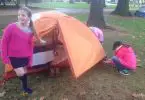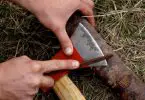Backpacking allows us to experience nature without disruption, see parts of the world inaccessible by any vehicle, and test our physical limits. Tent technology has advanced a long way since the days of canvas tarps and rigid steel poles, but the flood of new options can create as many issues as benefits.
See also: Tree Hanging Tents: How to Literally Get the Hang of Camping
Would-be backpackers find themselves overwhelmed by tents of all shapes and sizes, and even experts often disagree on the best choice – lightweight or ultralight? Polyester or nylon? Budget price or quality investment?
With so many options on the market claiming to be the perfect shelter, many people have started to opt for something a little more homemade. Making your own tent offers many benefits – it’s easier on your wallet, provides the same quality shelter as many store-bought options, and bestows you with a hefty amount of “rugged points”.
Below you’ll find a step-by-step guide on how to make your own DIY backpacking tent, from buying supplies to setting up camp.
What You’ll Need – Tarps, Rigging, and Accessories
First things first, “DIY” does not mean “out of thin air”. While some shelters can be made just from what you find in your environment, making a tent involves some prior planning. Most DIY tents utilize nothing more than a tarp, guylines, and poles, but these materials offer plenty of options that you can use to tailor your tent to your trip. Here are some tips for selecting the best materials:
Choose your tarp
Tarp tents have increased in popularity significantly in the last decade, and many companies capitalize on this fact by provided pre-cut tarps for campers. Pre-made tarps vary in material but usually consist of either urethane- or silicone-coated nylon, pre-sewn edges, and several outer grommets. These options range from around $40 to $150 and vary in weight from as little as 3 lbs. all the way up to 15 lbs. Check out our earlier piece on how to make DIY tarp tent for more information.
Purchasing a pre-cut tarp cuts time spent on designing and testing your tent, but comes with its own downfalls. Pre-cut means little flexibility in making changes or additions, and low grommet quality can make your backpacking experience a literal drag.
The second tarp option is to make your own. Tarp-connoisseurs tend to agree that coated nylon the best tent makes, and as with pre-cut tarps you have the option of urethane- or silicone-coat.
Both options are waterproof, tough, and flexible, but silicone boasts a weight difference of about 0.4-1.5oz per square yard less than urethane – and it’s the same material that many parachutes are made of, if you plan on using your tent to base jump (not recommended).
For a basic 1-2 person tent, you’ll need a rectangular piece between 8′-9′ long and 5′-6′ wide. For the more advanced design discussed below, you will need 6 yards of material at a standard 58” width.
Choose your rigging material
Whether or not your design uses poles, you will always need some sort of rope or webbing to keep your tent in place. Most tarp designs use a topline to keep standing, and you will need cord at least the length of your tent, plus several extra feet for tying your anchors. In addition, you’ll need several extra feet to use as guylines to keep the bottom edges of the tent anchored to the ground.
Your cord should be fairly strong, thin, flexible, and able to be cut and melted without fraying. Most nylon cord fits this profile, and options range from cheap, simple parachute cord such as Paracord to more expensive, but lightweight and reflective cord like Kelty Triptease. 50′ of cord ranges from $5 to $20, and will need to be replaced every few years depending on weather and usage.
Choose your poles
Poles create yet another conundrum for DIY tent-builders – so many options, oh my! Here are some useful guiding questions to ask yourself before making your choice:
-Do I need poles at all? Think about the environment you plan to backpack in. Are there trees, boulders, or other tall anchor points readily available? Are you confident you can find sticks or logs that can do the job?
-Should I buy poles or can I use trekking poles? Think about your weight and space requirements. Are you thru-hiking the Pacific Crest Trail or going on a quick overnight in the woods? Will extra poles take up pack space you don’t have?
With these questions in mind, let’s take a look at the options. If the no-pole lifestyle is for you, then congratulations, this part is done. Otherwise, you’ll need several pole segments to keep your tent up. For a basic tarp structure, you’ll need two poles about 36” tall. For a nicer design, you can use one 36” pole and one 18”.
Poles, like everything else, come in many different materials, and you need to decide which of these options is best as well. Aluminum is the go-to for many DIY backpackers because it is lightweight and inexpensive – unfortunately, it tends to bend over time with stress. Carbon fiber offers another, even lighter option, that is more rigid but more expensive. For tips on how to choose the best trekking poles, check out our article on this topic.
Tarp, rope, poles – the trifecta of a perfect DIY tent. Here’s three tables that summarizes the pros and cons of your options.
Tarps:
| Type | Pros | Cons |
| Pre-cut | Less time consuming; less difficult to use | More expensive; less flexible in design; potentially weak grommets |
| Hand-cut | More flexibility in design; hand-tailored to your needs; more affordable | More time consuming; more difficult to use |
| Urethane-coated nylon | More affordable | Less lightweight |
| Silicone-coated nylon | More lightweight | More expensive |
Rigging:
| Type | Pros | Cons |
| High-end | Reflective (no more tripping in the middle of the night!); lightweight | More expensive |
| Economy | As strong as high-end options; more affordable | Not reflective; more heavy |
Poles:
| Type | Pros | Cons |
| No poles or trekking poles | No additional cost; no added weight | Unreliable in environments without good anchors |
| Aluminum poles | More affordable; less likely to break under stress | Less lightweight; possibility to bend over time |
| Carbon fiber poles | Very lightweight; less likely to bend over time | More expensive; more likely to break under stress |
Structure Types and How to Make Them
So, you have your materials picked out – what comes next? This is where the tent-building experience becomes a creative endeavor. Below are three structures with step-by-step instructions on how to make them using your own tarp.
THE A-FRAME
This is the simplest structure to prepare and set up, and has been the go-to for outdoorsy-types for centuries. It offers basic protection from the elements, a quick set-up time, and, well, not much else. This structure leaves two open sides, so it’s not ideal for harsh weather or buggy environments and is better suited for warm summer nights and casual trips.
What You Need
- 5′ x 8′ or 6′ x 9′ rectangular tarp
- 4′ of 3/4” nylon tape or webbing
- Grommet kit, size 1
- Sewing machine
- Measuring tape
- 50′ nylon cord
- 6-8 stakes (optional)
- 2 36” poles (optional)
Preparing the Tent
- Fold the edges of the tarp over 1” and sew, forming a hemmed border all the way around.
- Use the measuring tape to measure and mark the halfway point on each edge
- Cut eight 5” lengths of nylon tape.
- For two nylon tape segments, fold in half and hammer a grommet near the tip of the fold.
- Sew one of the grommeted sections to the halfway mark on the short edge of the tarp. Repeat on the other side.
- Lay another nylon segment in front of you lengthwise.
- Fold each end up at a 90˚ angle, forming a flat V-shape. Do this with all six remaining segments.
- Sew the ends of the segments to each corner of the tent and each halfway mark on the long edges.
Setting Up
- If you’re not using poles, find two anchor points at least the length of your tent away from each other, mid-waist to chest height.
- Secure the ends of your nylon cord to the anchor points using a trucker’s hitch.
- Drape the tarp length-wise over the taut nylon cord.
- If you are using poles, secure the poles in the ground at the length or your tarp
- Secure your nylon cord to the poles and pull taut.
- Drape the tarp over the taut cord and push the tips of the poles into the grommeted nylon segments.
- Use additional segments of nylon cord to pull the corners and long edges taut, using stakes or ground anchors.
Viola! You have a tent. While it provides limited shelter, the A-frame allows you to see and listen to your surroundings as well as utilize your environment and cut down on gear. You can customize your tent by adding mosquito netting, front flaps, and even a sewn-in ground tarp. Let your creativity flow!
THE PARTIAL LEAN-TO
Lean-tos are another classic form of shelter that is easy to prepare and easy to set up. This option provides much more protection than the A-frame with only one open side, but is more limited in space. This is a good option for harsher weather conditions and areas where only one tall anchor can be found.
What You Need
- 5′ x 8′ or 6′ x 9′ rectangular tarp
- 4′ of 3/4” nylon tape or webbing
- Grommet kit, size 1
- Sewing machine
- Measuring tape
- 50′ nylon cord
- 7 stakes (optional)
Preparing the Tent
- Fold the edges of the tarp over 1” and sew, forming a hemmed border all the way around.
- Use the measuring tape to measure and mark the halfway point on each edge
- Cut eight 5” lengths of nylon tape.
- For one nylon tape segment, fold in half and hammer a grommet near the tip of the fold.
- Sew the grommeted section to the halfway mark on one short edge of the tarp.
- Lay another nylon segment in front of you lengthwise.
- Fold each end up at a 90˚ angle, forming a flat V-shape. Do this with all seven remaining segments.
- Sew the ends of the segments to each corner of the tent, each halfway mark on the long edges, and the halfway mark on the remaining short edge.
Setting Up
- Find a tall anchor point and secure the nylon cord to it using a trucker’s hitch
- Secure the other end of the nylon cord to the grommeted segment of the tarp using a trucker’s hitch or
- Stretch the tarp taut and secure the corners of the opposite short edge to the ground using stakes or ground anchors. The short edge should be parallel to the ground.
- Secure the remaining two corners to the ground using two segments of cord and stakes or ground anchors.
- Using two more segments of cord, pull the remaining two edges taut and anchor to the ground using stakes or ground anchors.
The finished product will have a triangular opening, triangular sides, and a triangular back all meeting at the top anchor point. This tent has a harsh angle, leaving little room for sitting up, but creates an enclosed space that provides better protection from the elements than the A-frame. Like above, you can personalize with mosquito netting and front flaps.
THE MODIFIED A-FRAME
This modified version of the basic A-frame provides more room and more protection than the standard A-frame by utilizing a sloping roof. It requires a little more work, but it’s worth it for DIY backpacking luxury.
What You Need
- 6 yards of coated nylon
- 4′ of 3/4” nylon tape or webbing
- Grommet kit, size 1
- Sewing machine
- Measuring tape
- 50′ nylon cord
- 6-8 stakes (optional)
- One 18” pole
- One 36” pole (optional)
Preparing the Tent
- Measure and cut two pieces of nylon with the following measurements: 98” long, 43” wide at one end, 29” long at the other end. The 98” length should form a 90˚ angle with the short edges, leaving one diagonal end.
- Sew the 98” sides together, forming a trapezoid.
- Follow steps 1-8 for preparing a basic A-frame.
Setting Up
- Secure your 36” pole to the ground or tie the nylon cord to a tall anchor point using a trucker’s hitch.
- Secure the long side grommeted nylon to the pole or the nylon cord.
- Secure the 18” pole to the ground, using the length of the tent as a guide. Secure the pole to the short side grommeted nylon.
- Use additional segments of cord and stakes or ground anchors to pull the corners and edges of the tent taut.
And it’s as simple as that. The tapered end provides more shelter than a basic A-frame and traps heat, making this a good option for harsher weather. This tent, as well as a basic A-frame, can be modified with mosquito netting sewn on the long edges, allowing for more air circulation and more headspace. Once again, customize to your heart’s delight!
General Tips for High Quality Shelter
Regardless of which tent you decide to build, there are some universal tricks. Always reduce as much slack in the tarp as possible to prevent water build-up and accidental showers when you emerge in the morning. Place your tent in the direction of the wind and don’t skimp on your anchors – no one wants their tent blowing away in the middle of the night. And of course, avoid game trails, washes and flood areas, bear dens, snake pits, etc. For more tips on how to pitch a tent, check out our article on this topic for information.
Summing Everything Up
To summarize – making your own tent has plenty of benefits. You can save money, weight, and encounters with over-eager store employees without sacrificing shelter and comfort.
We’ve learned about the pros and cons of different materials, like the difference between urethane- and silicon-coated nylon, the perks of reflective cord, and the best times and places for carbon fiber poles. Take a chance to try out the different designs on car camping trips or in your own backyard before heading out on the trail, and happy camping!
Featured Image Source: https://www.flickr.com/photos/swedish_heritage_board/6949802290/







